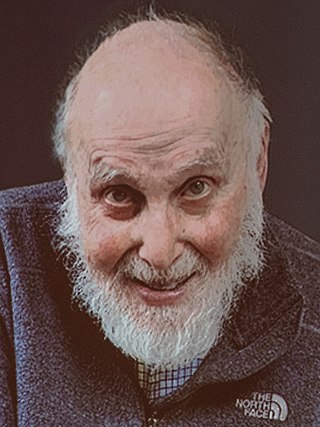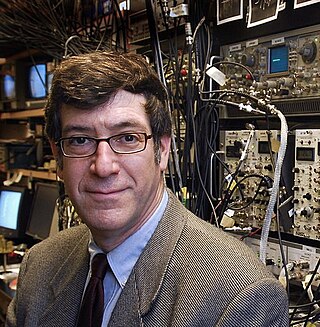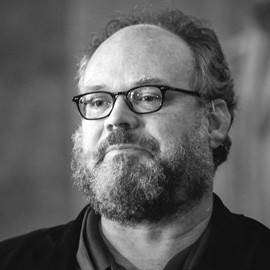Related Research Articles

Optical tweezers are scientific instruments that use a highly focused laser beam to hold and move microscopic and sub-microscopic objects like atoms, nanoparticles and droplets, in a manner similar to tweezers. If the object is held in air or vacuum without additional support, it can be called optical levitation.
The term biophotonics denotes a combination of biology and photonics, with photonics being the science and technology of generation, manipulation, and detection of photons, quantum units of light. Photonics is related to electronics and photons. Photons play a central role in information technologies, such as fiber optics, the way electrons do in electronics.
Quantum optics is a branch of atomic, molecular, and optical physics dealing with how individual quanta of light, known as photons, interact with atoms and molecules. It includes the study of the particle-like properties of photons. Photons have been used to test many of the counter-intuitive predictions of quantum mechanics, such as entanglement and teleportation, and are a useful resource for quantum information processing.

Gérard Albert Mourou is a French scientist and pioneer in the field of electrical engineering and lasers. He was awarded a Nobel Prize in Physics in 2018, along with Donna Strickland, for the invention of chirped pulse amplification, a technique later used to create ultrashort-pulse, very high-intensity (petawatt) laser pulses.

Arthur Ashkin was an American scientist and Nobel laureate who worked at Bell Laboratories and Lucent Technologies. Ashkin has been considered by many as the father of optical tweezers, for which he was awarded the Nobel Prize in Physics 2018 at age 96, becoming the oldest Nobel laureate until 2019 when John B. Goodenough was awarded at 97. He resided in Rumson, New Jersey.
Federico Capasso is an applied physicist and is one of the inventors of the quantum cascade laser during his work at Bell Laboratories. He is currently on the faculty of Harvard University.

The Institut d'optique Graduate School, nicknamed SupOptique or IOGS, is a graduate school of Paris-Saclay University and ParisTech.

Mark George Raizen is an American physicist who conducts experiments on quantum optics and atom optics.

Francisco Javier "Frank" Duarte is a laser physicist and author/editor of several books on tunable lasers.
The School of Mathematics and Physics (SMP) is in the Faculty of Science at The University of Queensland in Brisbane, Australia.

Ajoy Kumar Ghatak is an Indian physicist and author of physics textbooks.

Miles John Padgett is a Royal Society Research Professor of Optics in the School of Physics and Astronomy at the University of Glasgow. He has held the Kelvin Chair of Natural Philosophy since 2011 and served as Vice Principal for research at Glasgow from 2014 to 2020.
The Beckman Laser Institute is an interdisciplinary research center for the development of optical technologies and their use in biology and medicine. Located on the campus of the University of California, Irvine in Irvine, California, an independent nonprofit corporation was created in 1982, under the leadership of Michael W. Berns, and the actual facility opened on June 4, 1986. It is one of a number of institutions focused on translational research, connecting research and medical applications. Researchers at the institute have developed laser techniques for the manipulation of structures within a living cell, and applied them medically in treatment of skin conditions, stroke, and cancer, among others.

Matthew Davis is a New Zealand/Australian physicist, and is head of Physics at the University of Queensland, Australia. He is known for his work on the dynamics of vortices and superfluidity in Bose–Einstein condensates, particularly at finite temperatures.

Donna Theo Strickland is a Canadian optical physicist and pioneer in the field of pulsed lasers. She was awarded the Nobel Prize in Physics in 2018, together with Gérard Mourou, for the practical implementation of chirped pulse amplification. She is a professor at the University of Waterloo in Ontario, Canada.

Peter Barker is an Australian-born British physicist.
Warwick Bowen is an Australian quantum physicist and nanotechnologist at The University of Queensland. He leads the Quantum Optics Laboratory, is Director of the UQ Precision Sensing Initiative and is one of three Theme Leaders of the Australian Centre for Engineered Quantum Systems.

Anita Mahadevan-Jansen is a Professor of Biomedical Engineering and holds the Orrin H. Ingram Chair in Biomedical Engineering at Vanderbilt University. Her research considers the development of optical techniques for clinical diagnosis and surgical guidance, particularly using Raman and fluorescence spectroscopy. She serves on the Board of Directors of SPIE, and is a Fellow of SPIE, The Optical Society, Society for Applied Spectroscopy, and the American Society for Lasers in Medicine and Surgery. She was elected to serve as the 2020 Vice President of SPIE. With her election, Mahadevan-Jansen joined the SPIE presidential chain and served as President-Elect in 2021 and the Society's President in 2022.

Debabrata Goswami FInstP FRSC, is an Indian chemist and the Prof. S. Sampath Chair Professor of Chemistry, at the Indian Institute of Technology Kanpur. He is also a professor of The Department of Chemistry and The Center for Lasers & Photonics at the same Institute. Goswami is an associate editor of the open-access journal Science Advances. He is also an Academic Editor for PLOS One and PeerJ Chemistry. He has contributed to the theory of Quantum Computing as well as nonlinear optical spectroscopy. His work is documented in more than 200 research publications. He is an elected Fellow of the Royal Society of Chemistry, Fellow of the Institute of Physics, the SPIE, and The Optical Society. He is also a Senior Member of the IEEE, has been awarded a Swarnajayanti Fellowship for Chemical Sciences, and has held a Wellcome Trust Senior Research Fellowship. He is the third Indian to be awarded the International Commission for Optics Galileo Galilei Medal for excellence in optics.
References
- 1 2 3 4 Allen, Elizabeth (29 April 2000). "Atom lady". Courier Mail.
- 1 2 3 "Queen's Birthday honours for seven Academy Fellows | Australian Academy of Science". www.science.org.au. Retrieved 13 June 2018.
- 1 2 3 4 5 "Professor Halina Rubinsztein-Dunlop | Australian Academy of Science". www.science.org.au. Retrieved 6 March 2018.
- 1 2 "Prof. Halina Rubinsztein-Dunlop | ARC Centre of Excellence for Engineered Quantum Systems". equs.org. Retrieved 6 March 2018.
- ↑ "Halina Rubinsztein-Dunlop - 2010 SPIE Women in Optics Planner" . Retrieved 6 March 2018.
- 1 2 3 4 5 "Laser Sharp". spie.org. Retrieved 23 October 2018.
- ↑ "UQ remembers Emeritus Professor Keith Bullock, Dr Robert Wensley, QC and Emeritus Professor Gordon Dunlop". The Faculty of Engineering, Architecture and Information Technology. Archived from the original on 3 February 2018. Retrieved 6 March 2018.
- ↑ Rubinsztein, Halina (1978). "Atomic-beam magnetic resonance investigations of refractory elements and metastable states of lead" (in Swedish).
{{cite journal}}: Cite journal requires|journal=(help) - ↑ "History of Physics Department to 1998 - Physics Museum - The University of Queensland, Australia". physicsmuseum.uq.edu.au. Retrieved 6 March 2018.
- ↑ "Journal of Optics, Volume 13, Number 4, April 2011 - IOPscience". iopscience.iop.org. Retrieved 9 August 2018.
- 1 2 "UQ laser physicist recognised in Queen's birthday honours". School of Mathematics and Physics. 11 June 2018. Retrieved 13 June 2018.
- ↑ "Australian Honours database: Rubinsztein-Dunlop, Halina". Department of Prime Minister and Cabinet. Retrieved 4 July 2018.
- ↑ "Conference Detail for Optical Trapping and Optical Micromanipulation XV". spie.org. Retrieved 31 July 2018.
- ↑ "Eureka moment for leading UQ researchers". UQ News. Retrieved 23 October 2018.
- 1 2 "2018 Eureka Prizes Winners - Australian Museum". australianmuseum.net.au. Archived from the original on 1 September 2018. Retrieved 23 October 2018.
- ↑ "Halina Rubinsztein-Dunlop - Google Scholar Citations". scholar.google.co.uk. Retrieved 9 August 2018.
- ↑ "The Bose-Einstein Condensate Laboratory | ARC Centre of Excellence for Engineered Quantum Systems". equs.org. Retrieved 8 March 2018.
- ↑ "Tiny Einstein is created in super-cold microscopic detail". UQ News. Retrieved 23 October 2018.
- ↑ Gauthier, G.; Lenton, I.; Parry, N. McKay; Baker, M.; Davis, M. J.; Rubinsztein-Dunlop, H.; Neely, T. W. (20 October 2016). "Direct imaging of a digital-micromirror device for configurable microscopic optical potentials". Optica. 3 (10): 1136–1143. arXiv: 1605.04928 . Bibcode:2016Optic...3.1136G. doi:10.1364/OPTICA.3.001136. ISSN 2334-2536. S2CID 118593143.
- ↑ Rubinsztein-Dunlop, Halina; Nieminen, Timo A.; Stilgoe, Alexander B.; Asavei, Theodor; Loke, Vincent L. Y. (11 August 2014). "Driving corrugated donut rotors with Laguerre-Gauss beams". Optics Express. 22 (16): 19692–19706. Bibcode:2014OExpr..2219692L. doi: 10.1364/OE.22.019692 . ISSN 1094-4087. PMID 25321053. S2CID 3471445.
- ↑ He, H.; Friese, M. E. J.; Heckenberg, N. R.; Rubinsztein-Dunlop, H. (31 July 1995). "Direct Observation of Transfer of Angular Momentum to Absorptive Particles from a Laser Beam with a Phase Singularity" (PDF). Physical Review Letters. 75 (5): 826–829. Bibcode:1995PhRvL..75..826H. doi:10.1103/PhysRevLett.75.826. PMID 10060128.
- ↑ "Vertigo and understanding the body's balance system". ScienceDaily. Retrieved 9 August 2018.
- ↑ "Women in Physics Lecturer | Australian Institute of Physics". aip.org.au. Retrieved 8 March 2018.
- 1 2 "Prof. Halina Rubinsztein-Dunlop SPIE Profile".
- ↑ "Australian Optical Society - Halina Rubinsztein-Dunlop and Ben Eggleton, Fellows of the AAS". optics.org.au. Archived from the original on 11 March 2018. Retrieved 6 March 2018.
- ↑ "Abstract | German physic society" . Retrieved 9 September 2019.
- ↑ Lise-Meitner-Lectures 2019 - Interview with Prof. Halina Rubinsztein-Dunlop |access-date=2019-10-09
- ↑ "C.E.K. Mees Medal". The Optical Society.
- ↑ "NTT Basic Research Laboratories". www.brl.ntt.co.jp. Retrieved 9 August 2018.
- ↑ "Journal of Biophotonics". onlinelibrary.wiley.com. Retrieved 9 August 2018.
- ↑ "Beckman Laser Institute - Founder's Column Arnold Beckman Tribute". www.bli.uci.edu. Archived from the original on 4 March 2016. Retrieved 9 August 2018.
- ↑ "2012 OSA Fellows" . Retrieved 17 September 2019.